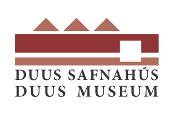A17
The Art Museum of Reykjanesbær presents a new exhibition in Duus Museum about Icelandic abstract art in the beginning of the 21st century. The exhibition consist of work made by seven artists; Áslaug Íris Katrín Friðjónsdóttir, Hadda Fjóla Reykdal, Halldór Ragnarsson, Logi Bjarnason, Magnús Helgason, Marta María Jónsdóttir og Sara Oskarsson. Curators are Aðalsteinn Ingólfsson and Bjarni Sigurbjörnsson.
During the last few decades, Icelandic abstract art, the art of intense subjectivity, lyricism and the inscrutable, has had a difficult time of it. Yet it was for some time the central paradigm of Icelandic art, and subsequently a viable and alternative to the Conceptual and Fluxus-based art that followed, During the Eighties and Nineties it was gradually sidelined and deemed irrelevant by some of the Icelandic art world's most influential power-brokers. Paradigm shifts are complex phenomena, but hopefully future scholars will be able to unravel the plot of that particular shift. It is all the more perplexing in that abstract art more than held it's own in Iceland's neighbouring countries during the same period.
In conversations and written statements, the artists in the A17 show have indicated that in order to devote themselves to abstract art, they virtually had to opt out of the Icelandic art scene, look for art schools outside Iceland and find themselves another ,,scene". Having done so, a ,,new world" was opened to them, to quote one of the artists. And what did this world reveal to them? they mention the international language of abstraction, its inexhaustible formal vocabulary, the sense of freedom that came with it, its challenging unpredictability, its emotional ,,charge" - and the possibility of creating for themselves an abstract space that was truly their own.
All above can be applied to the work of the seven artists in the A17 show. Moreover, they want to be taken seriously and have no intention of letting themselves be shunted aside in favor of other paradigms in the foreseeable future. The Reykjanes Museum thanks them for their participation and spirit of cooperation.
- Aðalsteinn Ingólfsson

